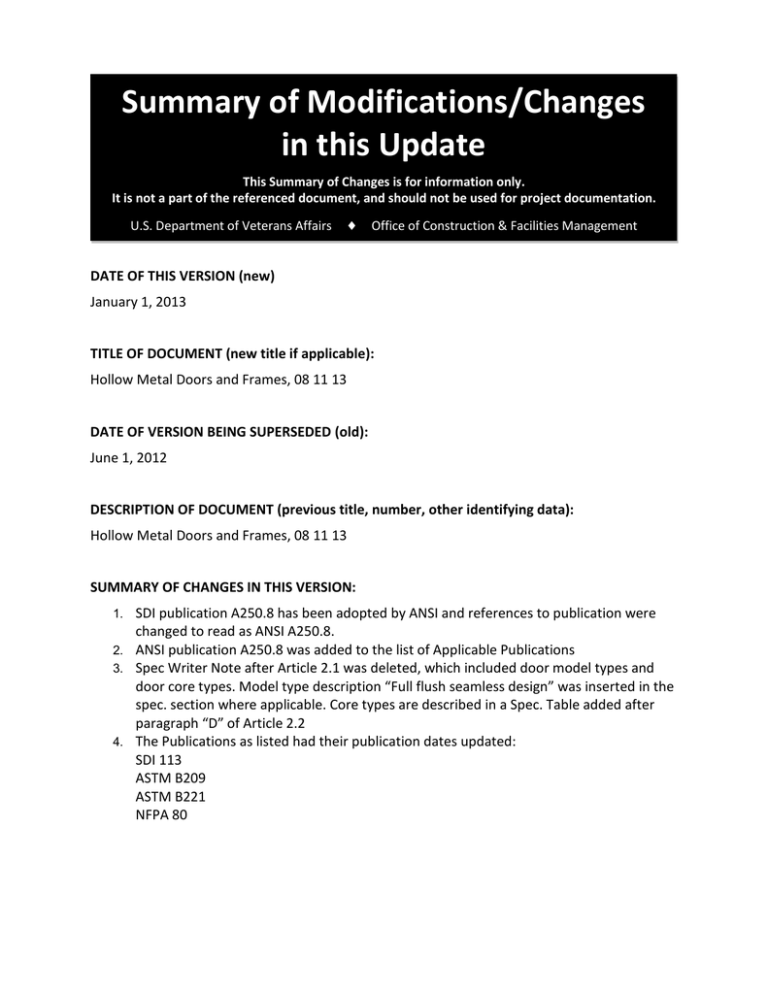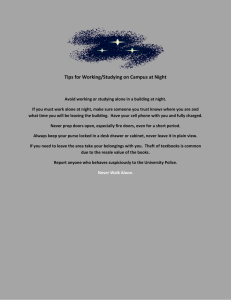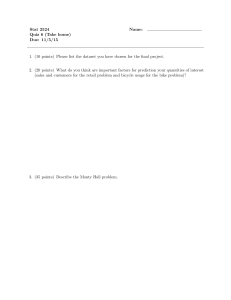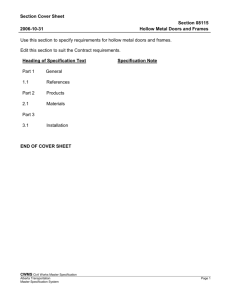Summary of Modifications/Changes in this Update
advertisement

Summary of Modifications/Changes in this Update This Summary of Changes is for information only. It is not a part of the referenced document, and should not be used for project documentation. U.S. Department of Veterans Affairs ♦ Office of Construction & Facilities Management DATE OF THIS VERSION (new) January 1, 2013 TITLE OF DOCUMENT (new title if applicable): Hollow Metal Doors and Frames, 08 11 13 DATE OF VERSION BEING SUPERSEDED (old): June 1, 2012 DESCRIPTION OF DOCUMENT (previous title, number, other identifying data): Hollow Metal Doors and Frames, 08 11 13 SUMMARY OF CHANGES IN THIS VERSION: SDI publication A250.8 has been adopted by ANSI and references to publication were changed to read as ANSI A250.8. 2. ANSI publication A250.8 was added to the list of Applicable Publications 3. Spec Writer Note after Article 2.1 was deleted, which included door model types and door core types. Model type description “Full flush seamless design” was inserted in the spec. section where applicable. Core types are described in a Spec. Table added after paragraph “D” of Article 2.2 4. The Publications as listed had their publication dates updated: SDI 113 ASTM B209 ASTM B221 NFPA 80 1. 01-01-13 SECTION 08 11 13 HOLLOW METAL DOORS AND FRAMES SPEC WRITER NOTE: 1. Delete between //---// if not applicable to project. Also delete any other item or paragraph not applicable in the section and insert additional items required by project and renumber paragraphs. Identify all frames by types. Verify that drawings show the required doors and frames. 2. See VA Physical Security Design Manual for security requirements. PART 1 - GENERAL 1.1 DESCRIPTION A. This section specifies steel doors, steel frames and related components. B. Terms relating to steel doors and frames as defined in ANSI A123.1 and as specified. 1.2 RELATED WORK A. Frames fabricated of structural steel: Section 05 50 00, METAL FABRICATIONS. B. Aluminum frames entrance work: Section 08 41 13, ALUMINUM-FRAMED ENTRANCES AND STOREFRONTS. C. Doors and frames of a forced entry/ballistic resistant rated: Section 08 34 53, SECURITY DOORS AND FRAMES. D. Overhead doors including loading docks: Section 08 33 00, COILING DOORS AND GRILLES. E. Windows and frames of a forced entry/ballistic resistant rated: Section 08 56 53, SECURITY WINDOWS. F. Door Hardware: Section 08 71 00, DOOR HARDWARE. G. Glazing and ballistic rated glazing: Section 08 80 00, GLAZING. H. Package transfer boxes: Section 11 17 36, PACKAGE TRANSFER UNITS. I. Steel mesh partitions, doors, service windows and hardware: Section 10 22 13, WIRE MESH PARTITIONS. J. Vault doors and day gates including frame and hardware: Section 08 34 59, VAULT DOORS AND DAY GATES. K. Deal trays of a Forced Entry/Ballistic Resistant rating: Section 08 56 59, SERVICE AND TELLER WINDOW UNITS. L. Guard Booths: Section 13 34 19, METAL BUILDING SYSTEMS. M. Card readers and biometric devices: Section 28 13 00, ACCESS CONTROL. 08 11 13-1 01-01-13 N. Intrusion Alarm: Section 28 16 11, INTRUSION DETECTION SYSTEM. O. Security Monitors: Section 28 51 00, SECURITY CONTROL CENTER. 1.3 TESTING An independent testing laboratory shall perform testing. 1.4 SUBMITTALS A. Submit in accordance with Section 01 33 23, SHOP DRAWINGS, PRODUCT DATA, AND SAMPLES. B. Manufacturers Literature and Data: 1. Fire rated doors and frames, showing conformance with NFPA 80 and Underwriters Laboratory, Inc., or Intertek Testing Services or Factory Mutual fire rating requirements // and temperature rise rating for stairwell doors. Submit proof of temperature rating //. 2. Sound rated doors, including test report from Testing Laboratory. 1.5 SHIPMENT A. Prior to shipment label each door and frame to show location, size, door swing and other pertinent information. B. Fasten temporary steel spreaders across the bottom of each door frame. 1.6 STORAGE AND HANDLING A. Store doors and frames at the site under cover. B. Protect from rust and damage during storage and erection until completion. 1.7 APPLICABLE PUBLICATIONS A. Publications listed below form a part of this specification to the extent referenced. Publications are referenced in the text by the basic designation only. B. Federal Specifications (Fed. Spec.): L-S-125B ............... Screening, Insect, Nonmetallic C. Door and Hardware Institute (DHI): A115 Series ............ Steel Door and Frame Preparation for Hardware, Series A115.1 through A115.17 (Dates Vary) D. Steel Door Institute (SDI): 113-01 (R2006) ......... Thermal Transmittance of Steel Door and Frame Assemblies 128-09 ................. Acoustical Performance for Steel Door and Frame Assemblies E. American National Standard Institute: A250.8-2003 (R2008) .... Specifications for Standard Steel Doors and Frames 08 11 13-2 01-01-13 F. American Society for Testing and Materials (ASTM): A167-99(R2009) ......... Stainless and Heat-Resisting Chromium-Nickel Steel Plate, Sheet, and Strip A568/568-M-11 .......... Steel, Sheet, Carbon, and High-Strength, Lowalloy, Hot-Rolled and Cold-Rolled A1008-10 ............... Steel, sheet, Cold-Rolled, Carbon, Structural, High Strength Low Alloy and High Strength Low Alloy with Improved Formability B209/209M-10 ........... Aluminum and Aluminum-Alloy Sheet and Plate B221/221M-12 ........... Aluminum and Aluminum-Alloy Extruded Bars, Rods, Wire, Profiles and Tubes D1621-10 ............... Compressive Properties of Rigid Cellular Plastics D3656-07 ............... Insect Screening and Louver Cloth Woven from Vinyl Coated Glass Yarns E90-09 ................. Laboratory Measurement of Airborne Sound Transmission Loss of Building Partitions G. The National Association Architectural Metal Manufactures (NAAMM): Metal Finishes Manual (AMP 500-06) H. National Fire Protection Association (NFPA): 80-13 .................. Fire Doors and Fire Windows I. Underwriters Laboratories, Inc. (UL): Fire Resistance Directory J. Intertek Testing Services (ITS): Certifications Listings…Latest Edition K. Factory Mutual System (FM): Approval Guide PART 2 - PRODUCTS SPEC WRITER NOTE: Make material requirements agree with applicable requirements specified in the referenced Applicable Publications. Update and specify only that which applies to the project. 2.1 MATERIALS A. Stainless Steel: ASTM A167, Type 302 or 304; finish, NAAMM Number 4. B. Sheet Steel: ASTM A1008, cold-rolled for panels (face sheets) of doors. C. Anchors, Fastenings and Accessories: Fastenings anchors, clips connecting members and sleeves from zinc coated steel. D. Insect Screening: ASTM D3656, 18 by 18 regular mesh. 08 11 13-3 01-01-13 E. Aluminum Sheet: ASTM B209/209M. F. Aluminum, Extruded: ASTM B221/221M. G. Prime Paint: Paint that meets or exceeds the requirements of A250.8. 2.2 FABRICATION GENERAL A. GENERAL: 1. Follow ANSI A250.8 for fabrication of standard steel doors, except as specified otherwise. Doors to receive hardware specified in Section 08 71 00, DOOR HARDWARE. Tolerances as per ANSI A250.8. Thickness, 44 mm (1-3/4 inches), unless otherwise shown. 2. Close top edge of exterior doors flush and seal to prevent water intrusion. 3. When vertical steel stiffeners are used for core construction, fill spaces between stiffeners with mineral fiber insulation. B. Standard Duty Doors: ANSI A250.8, Level 1, Full flush seamless design of size and design shown. Use for interior locations only. Do not use for stairwell doors, security doors and detention doors. C. Heavy Duty Doors: ANSI A250.8, Level 2, Full flush seamless design of size and design shown. Core construction types a, d, or f, for interior doors, and, types b, c, e, or f, for exterior doors. SPEC WRITER NOTE: Use the paragraph below for non Forced Entry/Ballistic Resistant door and frame assemblies. D. Extra Heavy Duty Doors: ANSI A250.8, Level 3, Full flush seamless design of size and design shown. Core construction Types d or f, for interior doors, and Types b, c, e, or f, for exterior doors. Use for detention doors, stairwell doors and security doors. See additional requirements for detention doors, under paragraph “Custom Hollow Metal Doors. Core Construction Type a b c d e f 08 11 13-4 Door Core Description Kraft honeycomb Polyurethane Polystyrene Unitized steel grid Mineral fiberboard Vertical steel stiffeners 01-01-13 E. Smoke Doors: 1. Close top and vertical edges flush. 2. Provide seamless vertical edges. 3. Apply Steel astragal to the meeting style at the active leaf of pair of doors or double egress doors. 4. Provide clearance at head, jamb and sill as specified in NFPA 80. F. Fire Rated Doors (Labeled): 1. Conform to NFPA 80 when tested by Underwriters Laboratories, Inc., Inchcape Testing Services, or Factory Mutual for the class of door or door opening shown. 2. Fire rated labels of metal, with raised or incised markings of approving laboratory shall be permanently attached to doors. 3. Close top and vertical edges of doors flush. Vertical edges shall be seamless. Apply steel astragal to the meeting stile of the active leaf of pairs of fire rated doors, except where vertical rod exit devices are specified for both leaves swinging in the same direction. 4. Construct fire rated doors in stairwell enclosures for maximum transmitted temperature rise of 230 °C (450 °F) above ambient temperature at end of 30 minutes of fire exposure when tested in accordance with ASTM E152. G. Custom Metal Hollow Doors: 1. Provide custom hollow metal doors where nonstandard steel doors are indicated. At the Contractor’s option, custom hollow metal doors may be provided in lieu of standard steel doors. Door size(s), design, materials, construction, gages and finish shall be as specified for of standard steel doors. 1. Dutch Doors: a. Construct with two leaves, of same construction as specified for flush doors. b. Fabricate shelves of not less than 1.3 mm (0.053 inch) thick // steel // stainless steel // of size shown. c. Stock type brackets fabricated of the same type metal used to fabricate shelves. d. Shelves and brackets may be either welded, bolted, or screwattached in place. SPEC WRITER NOTE: Delete following paragraph if all sound rated doors are wood, or have a STC less than specified. 08 11 13-5 01-01-13 H. Sound Rated Doors: 1. SDI 114, except as specified otherwise. 2. Sound Transmission Class minimum of 45 when tested in accordance with ASTM E90. 3. Doors complete with integral spring type automatic door bottom seal and with integral continuous gaskets on the frames. Applied spring type automatic door bottom seal and applied continuous gaskets for the frames for doors that are not sound rated but sealed for flanking noises are specified in Section 08 71 00, DOOR HARDWARE. 4. Fabricate vision panels to receive double glazing where shown. SPEC WRITER NOTE: Type 22 doors, specified below are special doors for use to Security Bedrooms except where fire doors are required. I. Detention Doors (Type 22): 1. ANSI A250.8, Level 3, Full flush seamless design with core Type ‘d’ or ‘f’. See Table with Core Types above. 2. Vision panels: a. Weld 3 mm (1/8 inch) thick steel channel reinforcements around cut-outs in doors to accommodate vision lights. b. Fabricate glazing stops on room side of doors, of 3 mm (1/8 inch) thick steel sheets mitered and welded at corners, and continuously welded both sides into doors. c. Fabricate glazing bead for corridor side of doors of 9 mm (3/8 inch) by 19 mm (3/4 inch) steel bar, miter and weld at the corners, and fasten to doors with 6 mm (1/4 inch) countersunk screws near corners and centers of each side. Back-up screw holes with 3 mm (1/8 inch) thick reinforcements, or weld nuts to back of the frames to receive screws. d. Size rabbet to provide for installation of safety glass and glazing cushions specified. SPEC WRITER NOTE: Add panel door types as designated. J. Tubular Steel Doors: 1. Industrial type. 2. Stiles and rails minimum of 125 mm (5 inches) by 44 mm (1-3/4 inches), formed of 1.3 mm (0.053 inch) thick steel tubular design, with locked seam. Bottom rail be 250 mm (10 inches) wide. 08 11 13-6 01-01-13 3. Louver and glazed opening sizes as shown. 4. Door panels; consist of two sheets of 1 mm (0.042 inch) thick steel with a resilient separator, nominally 9 mm (3/8 inch) thick, interlocked into the stiles and rails. SPEC WRITER NOTE: Verify all head, jamb and sill profiles are detailed and special conditions are detailed for all frames or specified. 2.3 METAL FRAMES A. General: 1. ANSI A250.8, 1.3 mm (0.053 inch) thick sheet steel, types and styles as shown or scheduled. 2. Frames for exterior doors: Fabricate from 1.7 mm (0.067 inch) thick galvanized steel conforming to ASTM A525. 3. Frames for labeled fire rated doors // and windows //. a. Comply with NFPA 80. Test by Underwriters Laboratories, Inc., Inchcape Testing Services, or Factory Mutual. b. Fire rated labels of approving laboratory permanently attached to frames as evidence of conformance with these requirements. Provide labels of metal or engraved stamp, with raised or incised markings. 4. Frames for lead-lined doors: SPEC WRITER NOTE: See VA Standard Detail 08110-3.DWG. a. Frames for doors 900 mm (3 feet) or less in width and having lead lining of 1 mm or less in thickness, and not shown to have structural steel supports: Minimum 1.7 mm (0.067 inch) thick. b. Frames for doors over 900 mm (3 feet) in width or having lead-lining more than 1 mm in thickness shown to be supported by and attached to structural steel subframes: Minimum 1.3 mm (0.053 inch) thick. c. Lead-lining and its application are specified in Section 13 49 00, RADIATION PROTECTION. 5. Frames for detention door (Type 22): Minimum 2 mm (0.093 inch) thick. 6. Frames for doors specified to have automatic door operators; Security doors (Type 36); service window: minimum 1.7 mm (0.067 inch) thick. 7. Knocked-down frames are not acceptable. 08 11 13-7 01-01-13 B. Reinforcement and Covers: 1. ANSI A250.8 for, minimum thickness of steel reinforcement welded to back of frames. 2. Provide mortar guards securely fastened to back of hardware reinforcements except on lead-lined frames. SPEC WRITER NOTE: Concealed door closers are generally limited to corridor doors to patient operating rooms. //3. Where concealed door closers are installed within the head of the door frames, prepare frames for closers and provide 1 mm (0.042 inch) thick steel removable stop sections for access to concealed face plates and control valves, except when cover plates are furnished with closer. // SPEC WRITER NOTE: Omit following paragraph when the building is a Research Laboratory, Mechanical or Electrical Building or any other non-patient building. If the project consists of patient and non-patient buildings, list non-patient building separately in blank spaces below. 150 mm (6 inch) maximum cut off is allowed for label doors. C. Terminated Stops: ANSI A250.8. D. Glazed Openings // and // Panel Opening //: a. Integral stop on exterior, corridor, or secure side of door. b. Design rabbet width and depth to receive glazing material or panel shown or specified. SPEC WRITER NOTE: Two piece frames are not used except for formed openings where frame is not pre-set in concrete, masonry walls, or in existing construction, and where sill sections occur under panel or glazed areas. Verify that details do not conflict. E. Two piece frames: a. One piece unequal leg finished rough buck sub-frames as shown, drilled for anchor bolts. b. Unequal leg finished frames formed to fit subframes and secured to subframe legs with countersunk, flat head screws, spaced 300 mm (12 inches) on center at head and jambs on each side. c. Preassemble at factory for alignment. 08 11 13-8 01-01-13 F. Frame Anchors: 1. Floor anchors: a. Where floor fills occur, provide extension type floor anchors to compensate for depth of fill. b. At bottom of jamb use 1.3 mm (0.053 inch) thick steel clip angles welded to jamb and drilled to receive two 6 mm (1/4 inch) floor bolts. Use 50 mm x 50 mm (2 inch by 2 inch) 9 mm by (3/8 inch) clip angle for lead lined frames, drilled for 9 mm (3/8 inch) floor bolts. c. Where mullions occur, provide 2.3 mm (0.093 inch) thick steel channel anchors, drilled for two 6 mm (1/4 inch) floor bolts and frame anchor screws. d. Where sill sections occur, provide continuous 1 mm (0.042 inch) thick steel rough bucks drilled for 6 mm (1/4 inch) floor bolts and frame anchor screws. Space floor bolts at 50 mm (24 inches) on center. 2. Jamb anchors: a. Locate anchors on jambs near top and bottom of each frame, and at intermediate points not over 600 mm (24 inches) apart, // except for fire rated frames space anchors as required by labeling authority //. b. Form jamb anchors of not less than 1 mm (0.042 inch) thick steel unless otherwise specified. c. Anchors set in masonry: Use adjustable anchors designed for friction fit against the frame and for extension into the masonry not less than 250 mm (10 inches). Use one of following type: 1) Wire loop type of 5 mm (3/16 inch) diameter wire. 2) T-shape or strap and stirrup type of corrugated or perforated sheet steel. d. Anchors for stud partitions: Either weld to frame or use lock-in snap-in type. Provide tabs for securing anchor to the sides of the studs. e. Anchors for frames set in prepared openings: 1) Steel pipe spacers with 6 mm (1/4 inch) inside diameter welded to plate reinforcing at jamb stops or hat shaped formed strap spacers, 50 mm (2 inches) wide, welded to jamb near stop. 2) Drill jamb stop and strap spacers for 6 mm (1/4 inch) flat head bolts to pass thru frame and spacers. 08 11 13-9 01-01-13 3) Two piece frames: Subframe or rough buck drilled for 6 mm (1/4 inch) bolts. f. Anchors for observation windows and other continuous frames set in stud partitions. 1) In addition to jamb anchors, weld clip anchors to sills and heads of continuous frames over 1200 mm (4 feet) long. 2) Anchors spaced 600 mm (24 inches) on centers maximum. g. Modify frame anchors to fit special frame and wall construction and provide special anchors where shown or required. 2.4 TRANSOM PANELS A. Fabricate panels as specified for flush doors. B. Fabricate bottom edge with rabbet stop to fit top of door where no transom bar occurs. 2.5 LOUVERS A. General: 1. Sight proof type with stationary blades the full thickness of the door. 2. Design lightproof louvers to exclude passage of light but permit free ventilation. 3. Provide insect screen and wire guards at exterior doors, except where doors are located below completely enclosed areaways, the wire guard is not required. B. Fabrication: 1. Steel louvers 0.8 mm (0.032 inch) thick for interior doors, and 1.3 mm (0.053 inch) inch thick for exterior doors. 2. Fabricate louvers as complete units. Install in prepared cutouts in doors. 3. Weld stationary blades to frames. Weld louvers into door openings. C. Screen frames: 1. Frame of either extruded aluminum or tubular aluminum. 2. Fabricate frame to hold wire fabric in a channel with a retaining bar anchor and to mount on surface of door with screws. 3. Do not lap frame over louver opening. 4. Miter corners of frame members and join by concealed mechanical fastenings extending about 57 mm (2-1/4 inches) into ends of each member. 08 11 13-10 01-01-13 5. Drill frame and doors for screw attachment. Space screws 50 mm (2 inches) from end of each leg of frame and not over 300 mm (12 inches) on center between end screws. 6. Finish: Clear anodized finish, 0.4 mils thick. 7. Insect Screens: Fasten insect screens to interior side of doors with retaining bar against door and not exposed to view. 8. Wire Guards: a. Wire fabric shall be wire guard screen as specified. b. Fasten wire guard to exterior side of door with retaining bar against door and not exposed to view. 2.6 SHOP PAINTING ANSI A250.8. PART 3 - EXECUTION 3.1 INSTALLATION A. Plumb, align and brace frames securely until permanent anchors are set. 1. Use triangular bracing near each corner on both sides of frames with temporary wood spreaders at midpoint. 2. Use wood spreaders at bottom of frame if the shipping spreader is removed. 3. Protect frame from accidental abuse. 4. Where construction will permit concealment, leave the shipping spreaders in place after installation, otherwise remove the spreaders after the frames are set and anchored. 5. Remove wood spreaders and braces only after the walls are built and jamb anchors are secured. B. Floor Anchors: 1. Anchor the bottom of door frames to floor with two 6 mm (1/4 inch) diameter expansion bolts. Use 9 mm (3/8 inch) bolts on lead lined frames. 2. Power actuated drive pins may be used to secure frame anchors to concrete floors. C. Jamb Anchors: 1. Anchors in masonry walls: Embed anchors in mortar. Fill space between frame and masonry wall with grout or mortar as walls are built. 2. Coat frame back with a bituminous coating prior to lining of grout filling in masonry walls. 08 11 13-11 01-01-13 3. Secure anchors to sides of studs with two fasteners through anchor tabs. Use steel drill screws to steel studs. 4. Frames set in prepared openings of masonry or concrete: Expansion bolt to wall with 6 mm (1/4 inch) expansion bolts through spacers. Where subframes or rough bucks are used, 6 mm (1/4 inch) expansion bolts on 600 mm (24 inch) centers or power activated drive pins 600 mm (24 inches) on centers. Secure two piece frames to subframe or rough buck with machine screws on both faces. D. Install anchors for labeled fire rated doors to provide rating as required. E. Frames for Sound Rated Doors: Coordinate to line frames for sound rated doors with insulation. F. Overhead Bracing (Lead Lined Frames): Where jamb extensions extend to structure above, anchor clip angles with not less than two, 9 mm (3/8 inch) expansion bolts or power actuated drive pins to concrete slab. Weld to steel overhead members. 3.2 INSTALLATION OF DOORS AND APPLICATION OF HARDWARE Install doors and hardware as specified in Sections // Section 08 11 13, HOLLOW METAL DOORS AND FRAMES // Section 08 14 00, WOOD DOORS // Section 08 71 00, DOOR HARDWARE //. - - - E N D - - - 08 11 13-12





